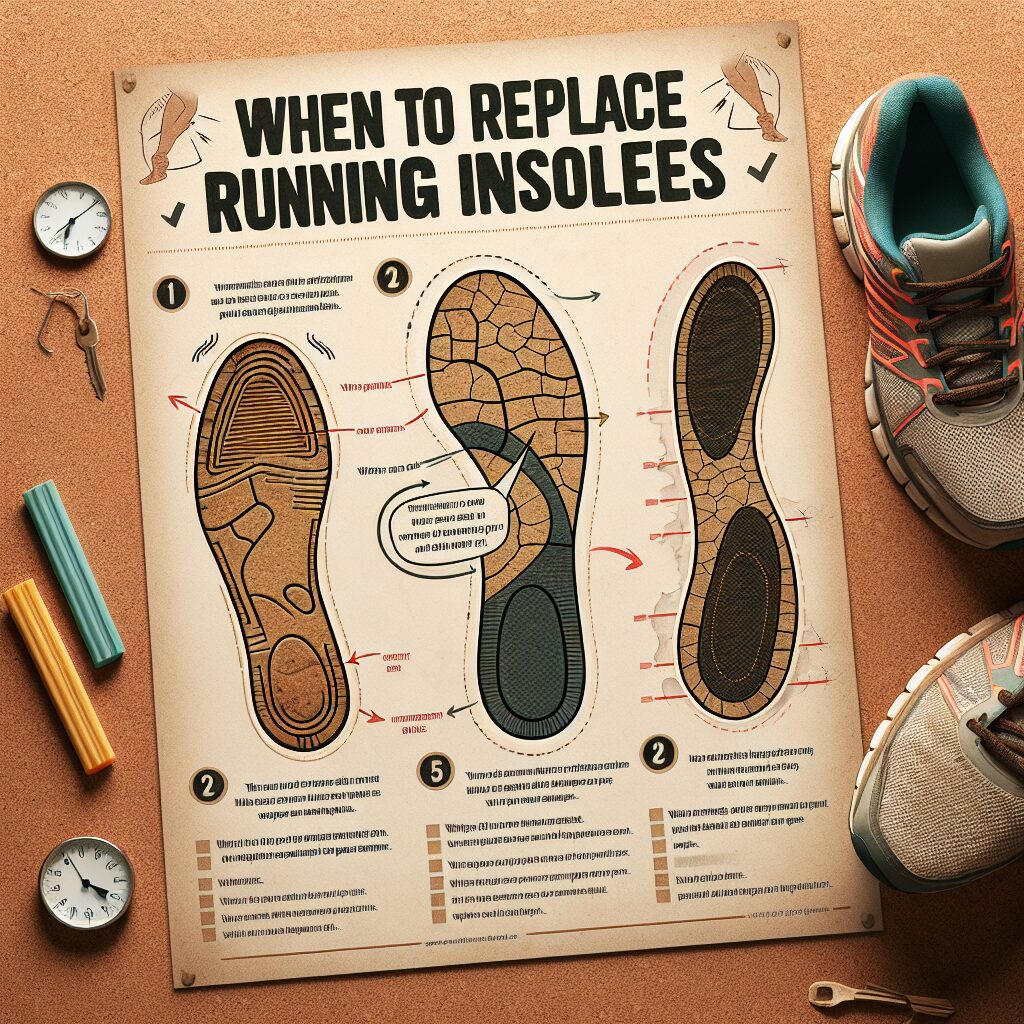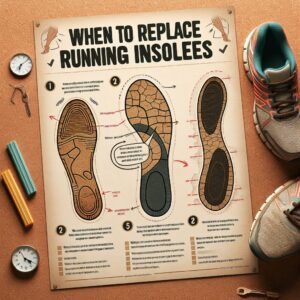
The Runner's Checklist: When to Replace Running Insoles
-
Table of Contents
Running shoe insoles should generally be replaced every 300 to 500 miles. However, if you experience discomfort or notice visible wear and tear before reaching this mileage, it may be necessary to replace them sooner. High-performance running shoes can have insoles that last up to 400 to 600 miles, but just like your running shoes, the insoles will eventually lose their effectiveness over an extended period of time. It is recommended to replace your running insoles at the same rate you replace your running shoes.
Understanding the Lifespan of Running Insoles: When to Replace Them

Running insoles, also known as footbeds or inner soles, are an integral part of a runner’s gear. They provide comfort, support, and shock absorption, thereby enhancing performance and reducing the risk of injuries. However, like any other piece of equipment, running insoles have a lifespan and need to be replaced periodically to maintain their effectiveness. Understanding the lifespan of running insoles and knowing when to replace them is crucial for every runner.
Running insoles are subjected to constant pressure and wear and tear. They bear the brunt of the impact every time the foot strikes the ground. Over time, this continuous stress can cause the insoles to lose their cushioning properties and structural integrity. When this happens, the insoles can no longer provide the necessary support and shock absorption, leading to discomfort and potentially, injuries.
The lifespan of running insoles largely depends on the frequency and intensity of use. On average, running insoles should be replaced every 300 to 500 miles. However, this is a general guideline and the actual lifespan can vary based on several factors. For instance, heavier runners may need to replace their insoles more frequently as they exert more pressure on the insoles. Similarly, runners who frequently run on rough terrains may also need to replace their insoles more often due to the increased wear and tear.
In addition to the mileage, there are other signs that indicate it’s time to replace your running insoles. If you start experiencing foot pain, discomfort, or blisters during or after your runs, it could be a sign that your insoles are worn out. Similarly, if you notice that your insoles have become flat, thin, or are showing signs of physical damage such as cracks or tears, it’s time to get a new pair.
It’s also important to note that even if your insoles appear to be in good condition, they may still need to be replaced. This is because the cushioning properties of the insoles can degrade over time, even if there are no visible signs of wear and tear. Therefore, it’s a good practice to replace your insoles regularly, even if they seem fine.
Replacing worn-out insoles is not just about maintaining comfort and performance. It’s also about preventing injuries. Worn-out insoles can lead to improper foot alignment and gait, which can in turn lead to a variety of injuries including shin splints, plantar fasciitis, and stress fractures. Therefore, timely replacement of running insoles is a small investment that can save you from pain, discomfort, and potentially, costly medical bills.
In conclusion, understanding the lifespan of running insoles and knowing when to replace them is an essential aspect of running gear maintenance. By paying attention to the mileage, monitoring for signs of wear and tear, and replacing the insoles regularly, you can ensure that your running insoles continue to provide the necessary support and shock absorption, thereby enhancing your running performance and reducing the risk of injuries. Remember, your running insoles are as important as your running shoes, and they deserve the same level of care and attention.
The Runner’s Guide: Identifying the Right Time to Replace Your Running Insoles
Running is a popular form of exercise that offers numerous health benefits. However, to ensure a safe and comfortable running experience, it’s crucial to maintain the quality of your running gear, particularly your running insoles. This article will serve as a guide to help you identify the right time to replace your running insoles.
Running insoles, also known as footbeds or inner soles, are a vital component of running shoes. They provide cushioning, support, and shock absorption, all of which are essential for a comfortable and injury-free run. However, like all parts of a running shoe, insoles are subject to wear and tear and will eventually need to be replaced.
The lifespan of running insoles varies depending on several factors, including the quality of the insoles, the runner’s weight, running style, and the frequency and intensity of runs. However, a general rule of thumb is to replace your running insoles every 300 to 500 miles. This is roughly the same mileage at which you would replace your running shoes.
Despite this general guideline, it’s important to listen to your body and pay attention to the condition of your insoles. If you start to experience discomfort or pain in your feet, ankles, knees, or hips during or after your runs, it may be a sign that your insoles are worn out and need to be replaced. Similarly, if you notice that your insoles are visibly worn, flattened, or damaged, it’s time to get a new pair.
In addition to physical signs, there are other indicators that your insoles may need replacing. If you find that your shoes are not as comfortable as they used to be, or if you’re getting blisters where you didn’t before, it could be due to worn-out insoles. Furthermore, if your shoes start to smell bad, even after cleaning, it could be a sign that your insoles are harboring bacteria and need to be replaced.
Replacing worn-out insoles is not just about maintaining comfort; it’s also about preventing injuries. Worn-out insoles can lead to poor foot support and alignment, which can in turn lead to injuries such as plantar fasciitis, shin splints, and runner’s knee. Therefore, timely replacement of your running insoles is crucial for maintaining good foot health and ensuring a safe and enjoyable running experience.
In conclusion, while the general guideline is to replace your running insoles every 300 to 500 miles, it’s important to pay attention to the physical condition of your insoles and listen to your body. If you start to experience discomfort, pain, or other changes in your running experience, it may be time to replace your insoles. Remember, maintaining good running gear is not just about comfort; it’s also about preventing injuries and ensuring a safe and enjoyable running experience. So, keep an eye on your insoles and replace them when necessary.
Maximizing Your Run: The Importance of Timely Replacement of Running Insoles
Running is a popular form of exercise that offers numerous health benefits, from improving cardiovascular health to boosting mental well-being. However, to maximize the benefits and minimize the risk of injury, it’s crucial to pay attention to the condition of your running gear, particularly your running insoles. This article will guide you through the importance of timely replacement of running insoles and provide a checklist to help you determine when it’s time to replace them.
Running insoles, also known as shoe inserts, play a significant role in providing comfort, support, and shock absorption. They help distribute the pressure evenly across your foot, reducing the risk of foot injuries and conditions such as plantar fasciitis and shin splints. However, like any other part of your running gear, insoles are subject to wear and tear. Over time, they lose their effectiveness, which can compromise your comfort and performance, and increase the risk of injury.
The lifespan of running insoles varies depending on several factors, including the quality of the insoles, the frequency and intensity of your runs, and your running style. However, a general rule of thumb is to replace them every 300 to 500 miles. This is roughly the same mileage at which you would replace your running shoes.
However, mileage alone should not be the sole determinant of when to replace your insoles. It’s essential to pay attention to the physical condition of the insoles and any changes in your comfort level during runs. If you notice that the insoles are visibly worn out, torn, or flattened, it’s time to replace them. Similarly, if you start experiencing foot pain, discomfort, or blisters during or after your runs, it could be a sign that your insoles are no longer providing adequate support and cushioning.
Another important factor to consider is the type of insoles. There are different types of running insoles designed for various purposes, such as cushioning insoles, support insoles, and custom orthotic insoles. Cushioning and support insoles typically need to be replaced more frequently due to their softer materials, while custom orthotic insoles tend to last longer due to their more durable materials.
In addition to these signs, it’s a good practice to have a spare pair of insoles. This allows you to switch between pairs, extending the lifespan of each pair and giving you a backup option if one pair becomes worn out or damaged.
In conclusion, timely replacement of running insoles is crucial for maintaining comfort, performance, and preventing injuries during runs. By keeping track of the mileage, regularly inspecting the physical condition of the insoles, and paying attention to your comfort level during runs, you can ensure that your insoles are always in optimal condition. Remember, investing in a good pair of running insoles and replacing them when necessary is an investment in your health and running performance.The Runner’s Checklist emphasizes the importance of regularly replacing running insoles to maintain foot health and optimal running performance. The lifespan of running insoles varies depending on usage, but signs of wear and tear, discomfort, or a decrease in performance are clear indicators that it’s time for a replacement. Therefore, runners should regularly inspect and assess their insoles to ensure they are providing the necessary support and cushioning.





